
a.
To calculate: The linear regression models and superimpose its graph on a
The obtained matrix is
Given Information:
The table is defined,
| Time (years) | Disbursements (billions of $) |
| 2005 | 336.9 |
| 2010 | 521.2 |
| 2011 | 560.3 |
| 2012 | 550.1 |
| 2013 | 581.7 |
| 2014 | 600.3 |
| 2015 | 638.1 |
Calculation:
Consider the given table,
| Time (years) | Disbursements (billions of $) |
| 2005 | 336.9 |
| 2010 | 521.2 |
| 2011 | 560.3 |
| 2012 | 550.1 |
| 2013 | 581.7 |
| 2014 | 600.3 |
| 2015 | 638.1 |
Use a graphing calculator to find the linear rgeression.
Step 1. Insert the table in calculator by using the table feature.
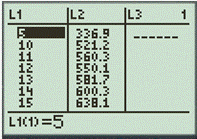
Step 2. Use the LinReg feature with first two list
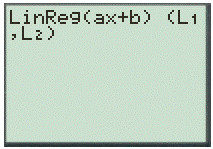
And,
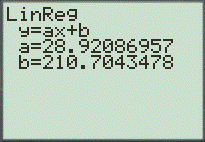
Step 3. Use the Graph feature to plot the both the graph as scatter graph.
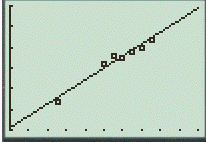
Therefore, the obtained equation is
b.
To calculate: The logistic regression model and superimpose its graph on a scatter plot of the data.
The obtained model is
Given Information:
The table is defined,
| Time (years) | Disbursements (billions of $) |
| 2005 | 336.9 |
| 2010 | 521.2 |
| 2011 | 560.3 |
| 2012 | 550.1 |
| 2013 | 581.7 |
| 2014 | 600.3 |
| 2015 | 638.1 |
Calculation:
Consider the given table,
| Time (years) | Disbursements (billions of $) |
| 2005 | 336.9 |
| 2010 | 521.2 |
| 2011 | 560.3 |
| 2012 | 550.1 |
| 2013 | 581.7 |
| 2014 | 600.3 |
| 2015 | 638.1 |
Use a graphing calculator to find the logestic model.
Step 1. Insert the table in calculator by using the table feature.
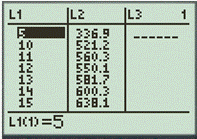
Step 2. Use the LinReg feature with first two list
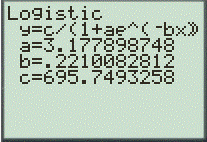
Step 3. Use the Graph feature to plot the both the graph as scatter graph.
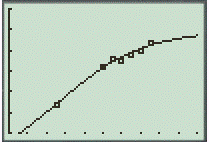
Hence, the obtained result is
c.
To determine: The models in parts (a) and (b) predict the same disbursement amounts.
The obtained model is
Given Information:
The table is defined,
| Time (years) | Disbursements (billions of $) |
| 2005 | 336.9 |
| 2010 | 521.2 |
| 2011 | 560.3 |
| 2012 | 550.1 |
| 2013 | 581.7 |
| 2014 | 600.3 |
| 2015 | 638.1 |
Calculation:
Consider the given table,
| Time (years) | Disbursements (billions of $) |
| 2005 | 336.9 |
| 2010 | 521.2 |
| 2011 | 560.3 |
| 2012 | 550.1 |
| 2013 | 581.7 |
| 2014 | 600.3 |
| 2015 | 638.1 |
Use a graphing calculator to find the logestic model.
Step 1. Insert the table in calculator by using the table feature.
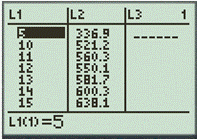
Step 2. Graph the both equations (a) and (b) then use the intersect feature to find the intersection point.
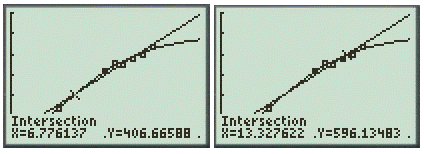
The x -coordinates are about 6.8 and 13.3, representing the years 2006 and 2013, respectively.
Hence, the obtained years are 2006 and 2013.
d.
To determine: The models, which appears to be a better fit for the data and explain which model would you choose to make predictions beyond 2020
The first choice is logistic model and then linear model.
Given Information:
The table is defined,
| Time (years) | Disbursements (billions of $) |
| 2005 | 336.9 |
| 2010 | 521.2 |
| 2011 | 560.3 |
| 2012 | 550.1 |
| 2013 | 581.7 |
| 2014 | 600.3 |
| 2015 | 638.1 |
Calculation:
Consider the given information,
The logistic model seems to be a better fit for the data since it passes most points compared to the linear model. For predictions beyond 2020, I would choose the linear model because the trend of the disbursement appears to be increasing.
The logistic model has a limiting growth of about 696 billion dollars which does not make sense in real life.
Hence, the first choice is logistic model and then linear model.
Chapter 7 Solutions
PRECALCULUS:...COMMON CORE ED.-W/ACCESS
- Under certain conditions, the number of diseased cells N(t) at time t increases at a rate N'(t) = Aekt, where A is the rate of increase at time 0 (in cells per day) and k is a constant. (a) Suppose A = 60, and at 3 days, the cells are growing at a rate of 180 per day. Find a formula for the number of cells after t days, given that 200 cells are present at t = 0. (b) Use your answer from part (a) to find the number of cells present after 8 days. (a) Find a formula for the number of cells, N(t), after t days. N(t) = (Round any numbers in exponents to five decimal places. Round all other numbers to the nearest tenth.)arrow_forwardThe marginal revenue (in thousands of dollars) from the sale of x handheld gaming devices is given by the following function. R'(x) = 4x (x² +26,000) 2 3 (a) Find the total revenue function if the revenue from 125 devices is $17,939. (b) How many devices must be sold for a revenue of at least $50,000? (a) The total revenue function is R(x) = (Round to the nearest integer as needed.) given that the revenue from 125 devices is $17,939.arrow_forwardUse substitution to find the indefinite integral. S 2u √u-4 -du Describe the most appropriate substitution case and the values of u and du. Select the correct choice below and fill in the answer boxes within your choice. A. Substitute u for the quantity in the numerator. Let v = , so that dv = ( ) du. B. Substitute u for the quantity under the root. Let v = u-4, so that dv = (1) du. C. Substitute u for the quantity in the denominator. Let v = Use the substitution to evaluate the integral. so that dv= ' ( du. 2u -du= √√u-4arrow_forward
- Use substitution to find the indefinite integral. Зи u-8 du Describe the most appropriate substitution case and the values of u and du. Select the correct choice below and fill in the answer boxes within your choice. A. Substitute u for the quantity in the numerator. Let v = , so that dv = ( ( ) du. B. Substitute u for the quantity under the root. Let v = u-8, so that dv = (1) du. C. Substitute u for the quantity in the denominator. Let v = so that dv= ( ) du. Use the substitution to evaluate the integral. S Зи -du= u-8arrow_forwardFind the derivative of the function. 5 1 6 p(x) = -24x 5 +15xarrow_forward∞ 2n (4n)! Let R be the radius of convergence of the series -x2n. Then the value of (3" (2n)!)² n=1 sin(2R+4/R) is -0.892 0.075 0.732 -0.812 -0.519 -0.107 -0.564 0.588arrow_forward
- Find the cost function if the marginal cost function is given by C'(x) = x C(x) = 2/5 + 5 and 32 units cost $261.arrow_forwardFind the cost function if the marginal cost function is C'(x) = 3x-4 and the fixed cost is $9. C(x) = ☐arrow_forwardFor the power series ∞ (−1)" (2n+1)(x+4)” calculate Z, defined as follows: n=0 (5 - 1)√n if the interval of convergence is (a, b), then Z = sin a + sin b if the interval of convergence is (a, b), then Z = cos asin b if the interval of convergence is (a, b], then Z = sin a + cos b if the interval of convergence is [a, b], then Z = cos a + cos b Then the value of Z is -0.502 0.117 -0.144 -0.405 0.604 0.721 -0.950 -0.588arrow_forward
- H-/ test the Series 1.12 7√2 by ratio best 2n 2-12- nz by vitio test enarrow_forwardHale / test the Series 1.12 7√2 2n by ratio best 2-12- nz by vico tio test en - プ n2 rook 31() by mood fest 4- E (^)" by root test Inn 5-E 3' b. E n n³ 2n by ratio test ٤ by Comera beon Test (n+2)!arrow_forwardEvaluate the double integral ' √ √ (−2xy² + 3ry) dA R where R = {(x,y)| 1 ≤ x ≤ 3, 2 ≤ y ≤ 4} Double Integral Plot of integrand and Region R N 120 100 80- 60- 40 20 -20 -40 2 T 3 4 5123456 This plot is an example of the function over region R. The region and function identified in your problem will be slightly different. Answer = Round your answer to four decimal places.arrow_forward
 Calculus: Early TranscendentalsCalculusISBN:9781285741550Author:James StewartPublisher:Cengage Learning
Calculus: Early TranscendentalsCalculusISBN:9781285741550Author:James StewartPublisher:Cengage Learning Thomas' Calculus (14th Edition)CalculusISBN:9780134438986Author:Joel R. Hass, Christopher E. Heil, Maurice D. WeirPublisher:PEARSON
Thomas' Calculus (14th Edition)CalculusISBN:9780134438986Author:Joel R. Hass, Christopher E. Heil, Maurice D. WeirPublisher:PEARSON Calculus: Early Transcendentals (3rd Edition)CalculusISBN:9780134763644Author:William L. Briggs, Lyle Cochran, Bernard Gillett, Eric SchulzPublisher:PEARSON
Calculus: Early Transcendentals (3rd Edition)CalculusISBN:9780134763644Author:William L. Briggs, Lyle Cochran, Bernard Gillett, Eric SchulzPublisher:PEARSON Calculus: Early TranscendentalsCalculusISBN:9781319050740Author:Jon Rogawski, Colin Adams, Robert FranzosaPublisher:W. H. Freeman
Calculus: Early TranscendentalsCalculusISBN:9781319050740Author:Jon Rogawski, Colin Adams, Robert FranzosaPublisher:W. H. Freeman
 Calculus: Early Transcendental FunctionsCalculusISBN:9781337552516Author:Ron Larson, Bruce H. EdwardsPublisher:Cengage Learning
Calculus: Early Transcendental FunctionsCalculusISBN:9781337552516Author:Ron Larson, Bruce H. EdwardsPublisher:Cengage Learning





